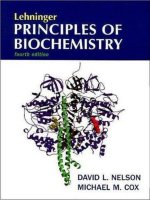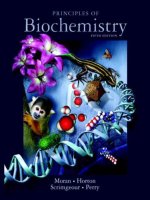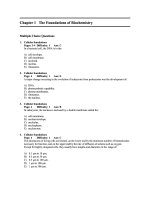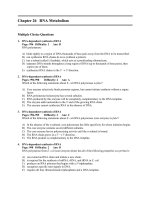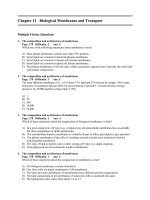kupdf com lehninger principles of biochemistry test bank ch 25pdf
Bạn đang xem bản rút gọn của tài liệu. Xem và tải ngay bản đầy đủ của tài liệu tại đây (191.64 KB, 12 trang )
Chapter 25 DNA Metabolism
Multiple Choice Questions
1. DNA replication
Page: 950 Difficulty: 2 Ans: C
The Meselson-Stahl experiment established that:
A)
B)
C)
D)
E)
DNA polymerase has a crucial role in DNA synthesis.
DNA synthesis in E. coli proceeds by a conservative mechanism.
DNA synthesis in E. coli proceeds by a semiconservative mechanism.
DNA synthesis requires dATP, dCTP, dGTP, and dTTP.
newly synthesized DNA in E. coli has a different base composition than the preexisting DNA.
2. DNA replication
Page: 951 Difficulty: 2 Ans: D
When a DNA molecule is described as replicating bidirectionally, that means that it has two:
A)
B)
C)
D)
E)
chains.
independently replicating segment.
origins.
replication forks.
termination points.
3. DNA replication
Page: 952 Difficulty: 2 Ans: D
An Okazaki fragment is a:
A)
B)
C)
D)
E)
fragment of DNA resulting from endonuclease action.
fragment of RNA that is a subunit of the 30S ribosome.
piece of DNA that is synthesized in the 3' → 5' direction.
segment of DNA that is an intermediate in the synthesis of the lagging strand.
segment of mRNA synthesized by RNA polymerase.
4. DNA replication
Pages: 952-958
Difficulty: 2 Ans: C
Which one of the following statements about enzymes that interact with DNA is true?
A)
B)
C)
D)
E)
E. coli DNA polymerase I is unusual in that it possesses only a 5' → 3' exonucleolytic activity.
Endonucleases degrade circular but not linear DNA molecules.
Exonucleases degrade DNA at a free end.
Many DNA polymerases have a proofreading 5' → 3' exonuclease.
Primases synthesize a short stretch of DNA to prime further synthesis.
290
Chapter 25 DNA Metabolism
5. DNA replication
Page: 955 Difficulty: 2 Ans: C
E. coli DNA polymerase III:
A)
B)
C)
D)
E)
can initiate replication without a primer.
is efficient at nick translation.
is the principal DNA polymerase in chromosomal DNA replication.
represents over 90% of the DNA polymerase activity in E. coli cells.
requires a free 5'-hydroxyl group as a primer.
6. DNA replication
Page: 955 Difficulty: 3 Ans: E
The proofreading function of DNA polymerase involves all of the following except:
A)
B)
C)
D)
E)
a 3' → 5' exonuclease.
base pairing.
detection of mismatched base pairs.
phosphodiester bond hydrolysis.
reversal of the polymerization reaction.
7. DNA replication
Page: 956 Difficulty: 2 Ans: D
The 5' → 3' exonuclease activity of E. coli DNA polymerase I is involved in:
A)
B)
C)
D)
E)
formation of a nick at the DNA replication origin.
formation of Okazaki fragments.
proofreading of the replication process.
removal of RNA primers by nick translation.
sealing of nicks by ligase action.
8. DNA replication
Pages: 956-957
Difficulty: 2
Prokaryotic DNA polymerase III:
A)
B)
C)
D)
E)
Ans: C
contains a 5' → 3' proofreading activity to improve the fidelity of replication.
does not require a primer molecule to initiate replication.
has a β subunit that acts as a circular clamp to improve the processivity of DNA synthesis.
synthesizes DNA in the 3' → 5' direction.
synthesizes only the leading strand; DNA polymerase I synthesizes the lagging strand.
9. DNA replication
Page: 961 Difficulty: 2 Ans: E
At replication forks in E. coli:
A)
B)
C)
D)
E)
DNA helicases make endonucleolytic cuts in DNA.
DNA primers are degraded by exonucleases.
DNA topoisomerases make endonucleolytic cuts in DNA.
RNA primers are removed by primase.
RNA primers are synthesized by primase.
Chapter 25 DNA Metabolism
291
10. DNA replication
Pages: 964-965
Difficulty: 2 Ans: D
In contrast to bacteria, eukaryotic chromosomes need multiple DNA replication origins because:
A)
B)
C)
D)
eukaryotic chromosomes cannot usually replicate bidirectionally.
eukaryotic genomes are not usually circular, like the bacterial chromosome is.
the processivity of the eukaryotic DNA polymerase is much less than the bacterial enzyme.
their replication rate is much slower, and it would take too long with only a single origin per
chromosome.
E) they have a variety of DNA polymerases for different purposes, and need a corresponding variety
of replication origins.
11. DNA replication
Page: 965 Difficulty: 2 Ans: B
The function of the eukaryotic DNA replication factor PCNA (proliferating cell nuclear antigen) is
similar to that of the β-subunit of bacterial DNA polymerase III in that it:
A)
B)
C)
D)
E)
facilitates replication of telomeres.
forms a circular sliding clamp to increase the processivity of replication.
has a 3' → 5' proofreading activity.
increases the speed but not the processivity of the replication complex.
participates in DNA repair.
12. DNA repair
Page: 967 Difficulty: 2
The Ames test is used to:
A)
B)
C)
D)
E)
Ans: D
detect bacterial viruses.
determine the rate of DNA replication.
examine the potency of antibiotics.
measure the mutagenic effects of various chemical compounds.
quantify the damaging effects of UV light on DNA molecules.
13. DNA repair
Page: 967 Difficulty: 2 Ans: E
In a mammalian cell, DNA repair systems:
A)
B)
C)
D)
E)
are extraordinarily efficient energetically.
are generally absent, except in egg and sperm cells.
can repair deletions, but not mismatches.
can repair most types of lesions except those caused by UV light.
normally repair more than 99% of the DNA lesions that occur.
292
Chapter 25 DNA Metabolism
14. DNA repair
Pages: 967-969
Difficulty: 3 Ans: A
Which of these enzymes is not directly involved in methyl-directed mismatch repair in E. coli?
A)
B)
C)
D)
E)
DNA glycosylase
DNA helicase II
DNA ligase
DNA polymerase III
Exonuclease I
15. DNA repair
Page: 968 Difficulty: 2 Ans: B
The role of the Dam methylase is to:
A)
B)
C)
D)
E)
add a methyl group to uracil, converting it to thymine.
modify the template strand for recognition by repair systems.
remove a methyl group from thymine.
remove a mismatched nucleotide from the template strand.
replace a mismatched nucleotide with the correct one.
16. DNA repair
Page: 968 Difficulty: 2 Ans: D
When bacterial DNA replication introduces a mismatch in a double-stranded DNA, the methyldirected repair system:
A)
B)
C)
D)
E)
cannot distinguish the template strand from the newly replicated strand.
changes both the template strand and the newly replicated strand.
corrects the DNA strand that is methylated.
corrects the mismatch by changing the newly replicated strand.
corrects the mismatch by changing the template strand.
17. DNA repair
Pages: 971-972
Difficulty: 2 Ans: C
In base-excision repair, the first enzyme to act is:
A)
B)
C)
D)
E)
AP endonuclease.
Dam methylase.
DNA glycosylase.
DNA ligase.
DNA polymerase.
18. DNA repair
Pages: 972-973
Difficulty: 2
Ans: D
The ABC excinuclease is essential in:
A)
B)
C)
D)
E)
base-excision repair.
methyl-directed repair.
mismatch repair.
nucleotide-excision repair.
SOS repair.
Chapter 25 DNA Metabolism
293
19. DNA repair
Page: 974 Difficulty: 2 Ans: C
The repair of cyclobutane pyrimidine dimers by bacterial DNA photolyase involves the cofactor:
A)
B)
C)
D)
E)
coenzyme A.
coenzyme Q.
FADH–.
pyridoxal phosphate (PLP).
thiamine pyrophosphate (TPP).
20. DNA repair
Pages: 976-977
Difficulty: 2 Ans: E
An alternative repair system by error-prone translesion DNA synthesis can result in a high mutation
rate, because:
A)
B)
C)
D)
E)
alternative modified nucleotides can be incorporated more readily.
interference from the RecA and SSB proteins hinders the normal replication accuracy.
replication proceeds much faster than normal, resulting in many more mistakes.
the DNA polymerases involved cannot facilitate base-pairing as well as DNA polymerase III.
the DNA polymerases involved lack exonuclease proofreading activities.
21. DNA recombination
Page: 982 Difficulty: 2 Ans: D
In homologous recombination in E. coli, the protein that moves along a double-stranded DNA,
unwinding the strands ahead of it and degrading them, is:
A)
B)
C)
D)
E)
chi.
DNA ligase.
RecA protein.
RecBCD enzyme.
RuvC protein (resolvase).
22. DNA recombination
Pages: 982-983
Difficulty: 2 Ans: D
In homologous recombination in E. coli, the protein that assembles into long, helical filaments that
coat a region of DNA is:
A)
B)
C)
D)
E)
DNA methylase.
DNA polymerase.
histone.
RecA protein.
RecBCD enzyme.
294
Chapter 25 DNA Metabolism
23. DNA recombination
Pages: 982-983
Difficulty: 2 Ans: A
In homologous genetic recombination, RecA protein is involved in:
A)
B)
C)
D)
formation of Holliday intermediates and branch migration.
introduction of negative supercoils into the recombination products.
nicking the two duplex DNA molecules to initiate the reaction.
pairing a DNA strand from one duplex DNA molecule with sequences in another duplex,
regardless of complementarity.
E) resolution of the Holliday intermediate.
24. DNA recombination
Page: 983 Difficulty: 2 Ans: E
Which of the following statements is false? In vitro, the strand-exchange reaction:
A)
B)
C)
D)
E)
can include formation of a Holliday intermediate.
is accompanied by ATP hydrolysis.
may involve transient formation of a three- or four-stranded DNA complex.
needs RecA protein.
requires DNA polymerase.
25. DNA recombination
Page: 987 Difficulty: 3 Ans: C
The bacteriophage λ can lysogenize after infecting a bacterium, i.e. integrate into the host bacterial
chromosome by site-specific recombination, and may reside there for many generations before an
excision event regenerates the viral genome in an infective form. Which one of the following is not a
component of these events?
A)
B)
C)
D)
E)
Excision requires two host proteins and two virally-encoded proteins.
Integration requires a viral-specific protein, called integrase.
RecA protein is required to catalyze the insertional recombination event.
The excision event relies on different sequences than the integration event.
The virus and the host DNAs share a 15 bp “core” region of perfect homology.
Short Answer Questions
26. DNA replication
Pages: 950-951
Difficulty: 2
Describe briefly how equilibrium density gradient centrifugation was used to demonstrate that DNA
replication in E. coli is semiconservative.
Ans: Equilibrium density gradient centrifugation separates DNA molecules of slightly different
buoyant density. For example, molecules containing 15N-labeled (“heavy”) DNA are separable from
identical molecules containing 14N (“light”) DNA. Meselson and Stahl grew E. coli for many
generations in a medium containing 15N, producing cells in which all DNA was heavy. These cells
were transferred to a medium containing 14N, and the buoyant density of their DNA was determined
(by equilibrium density gradient centrifugation) after 1, 2, 3, etc., generations. After one generation,
all DNA was of a density intermediate between fully heavy and fully light, indicating that each
double-stranded DNA molecule had one heavy (parental) and one light (newly synthesized) strand;
Chapter 25 DNA Metabolism
295
replication was semiconservative. (See Fig. 25-2, p. 950.)
27. DNA replication
Page: 952 Difficulty: 2
The DNA below is replicated from left to right. Label the templates for leading strand and lagging
strand synthesis.
(5')ACTTCGGATCGTTAAGGCCGCTTTCTGT(3')
(3')TGAAGCCTAGCAATTCCGGCGAAAGACA(5')
Ans: The polarity of the strands indicates that the top strand is the template for lagging strand
synthesis, and the bottom strand is the template for leading strand synthesis. (See Fig. 25-4, p. 952.)
28. DNA replication
Page: 952 Difficulty: 2
All known DNA polymerases catalyze synthesis only in the 5' → 3' direction. Nevertheless, during
semiconservative DNA replication in the cell, they are able to catalyze the synthesis of both daughter
chains, which would appear to require synthesis in the 3' → 5' direction. Explain the process that
occurs in the cell that allows for synthesis of both daughter chains by DNA polymerase.
Ans: During DNA replication, one strand is synthesized continuously and the other is synthesized by
a discontinuous mechanism. The daughter chain, which appears to be growing in the 3' → 5'
direction (the “lagging strand”), is actually being synthesized by continual initiation of new chains
and their elongation in the 5' → 3' direction.
29. DNA replication
Pages: 952, 960
Difficulty: 2
What is an Okazaki fragment? What enzyme(s) is (are) required for its formation in E. coli?
Ans: An Okazaki fragment is an intermediate in DNA replication in E. coli. It is a short fragment of
newly synthesized DNA, attached to the 3' end of a short RNA primer. Such fragments are produced
by the combined action of primase (part of the primosome) and DNA polymerase III during
replication of the lagging strand. (See Fig. 25-13, p. 960.)
30. DNA replication
Page: 953 Difficulty: 3
Diagram the reaction catalyzed by DNA polymerase that occurs between deoxyribose at the end of a
DNA chain and the 5' phosphates of a deoxyribonucleoside triphosphate. Include the chemical
structure of the phosphate group, indicate the locations of the sugar and base, and show the
rearrangements of electrons that occur.
Ans: See Fig. 25-5, p. 953.
31. DNA replication
Page: 953 Difficulty: 2
Nucleotide polymerization appears to be a thermodynamically balanced reaction (because one
phosphodiester bond is broken and one is formed). Nevertheless, the reaction proceeds efficiently
both in a test tube and in the cell. Explain.
Ans: Base-stacking and base-pairing interactions in the polymerized DNA product stabilize it and tend
296
Chapter 25 DNA Metabolism
to make the overall reaction more exergonic. In the cell, pyrophosphatase may make a contribution by
coupling polymerization to the highly exergonic hydrolysis of the pyrophosphate product.
32. DNA replication
Pages: 953-954
Difficulty: 2
A suitable substrate for DNA polymerase is shown below. Label the primer and template, and
indicate which end of each strand must be 3' or 5'.
To observe DNA synthesis on this substrate in vitro, what additional reaction components must be
added?
Ans: The top strand (the primer) has its 5' end to the left; the bottom (template) strand has the
opposite polarity. For DNA synthesis with this substrate in vitro, one would have to add DNA
polymerase, the four deoxynucleoside triphosphates, Mg2+, and a suitable buffer.
33. DNA replication
Pages: 954, 958
Difficulty: 2
All known DNA polymerases can only elongate a preexisting DNA chain (i.e., require a primer), but
cannot initiate a new DNA chain. Nevertheless, during semiconservative DNA replication in the cell,
entirely new daughter DNA chains are synthesized. Explain the process that occurs in the cell that
allows for the synthesis of daughter chains by DNA polymerase.
Ans: In the cell, initiation of DNA chains occurs via the synthesis of an RNA primer by an RNA
polymerase type of enzyme (primase). This primer is elongated by DNA polymerase to produce the
daughter DNA chain. The RNA is removed by 5' exonucleolytic hydrolysis before replication is
completed.
34. DNA replication
Pages: 958-962
Difficulty: 2
DNA replication in E. coli begins at a site in the DNA called the (a) ___________. At the replication
fork the (b) ___________ strand is synthesized continuously while the (c) _________ strand is
synthesized discontinuously. On the strand synthesized discontinuously, the short pieces are called
(d) ____________ fragments. An RNA primer for each of the fragments is synthesized by an enzyme
called (e) __________, and this RNA primer is removed after the fragment is synthesized by the
enzyme (f) ___________, using its (g) _____________ activity. The nicks left behind in this process
are sealed by the enzyme (h) _____________.
Ans: (a) origin; (b) leading; (c) lagging; (d) Okazaki; (e) primase; (f) DNA pol I; (g) 5' → 3'
exonuclease; (h) DNA ligase
35. DNA replication
Pages: 958-961
Difficulty: 2
Briefly describe the biochemical role of the following enzymes in DNA replication in E. coli:
(a) DNA helicase; (b) primase; (c) the 3' → 5' exonuclease activity of DNA polymerase; (d) DNA
1igase; (e) topoisomerases; (f) the 5' → 3' exonuclease activity of DNA polymerase I.
Chapter 25 DNA Metabolism
297
Ans: (a) Helicase unwinds double-stranded DNA during replication. (b) Primase synthesizes short
RNA primers during lagging strand replication. (c) The 3' → 5' exonuclease activity of DNA
polymerase proofreads newly synthesized DNA, removing mismatched nucleotides. (d) DNA ligase
seals nicks in the DNA at the boundaries between Okazaki fragments. (e) Topoisomerases relieves
the topological stress produced by the unwinding of double-stranded DNA at the replication fork. (f)
The 5' → 3' exonuclease activity of DNA polymerase I removes RNA primers.
36. DNA replication
Pages: 961-962
Difficulty: 2
DNA synthesis on the lagging strand in E. coli is a complex process known to involve several
proteins. Initiation of a new chain is catalyzed by the enzyme (a) _____________, and elongation is
catalyzed by the enzyme (b)______________. Synthesis is discontinuous, yielding short segments
called (c) _______________, which are eventually joined by the enzyme (d)______________, which
requires the cofactor (e)___________.
Ans: (a) primase; (b) DNA pol III; (c) Okazaki fragments; (d) DNA ligase; (e) NAD+
37. DNA replication
Page: 962 Difficulty: 2
List two proteins or enzymes, other than DNA polymerase III, that are found at the replication fork in
E. coli; describe each of their functions with no more than one sentence.
Ans: The proteins are listed in Table 25-4, p. 962. They include (a) DNA polymerase I, which fills
gaps and excises RNA primers; (b) primase (the DnaG protein), which synthesizes short RNA
primers; (c) DNA ligase, which seals nicks; and (d) proteins that aid in DNA unwinding and
supercoiling.
38. DNA replication
Pages: 963-964
Difficulty: 2
In the bacterial cell, what are catenated chromosomes, when do they arise, and how does the cell
resolve the problem posed by their structure?
Ans: Catenanes are topologically interlinked circular chromosomes, which are the normal end result
of DNA replication of the parental circular genome when the bidirectional replication forks meet.
They are unlinked by the bacterial topoisomerase IV (a type II enzyme), and thus become free to
segregate into daughter cells upon cell division. (See Fig. 25-17, p. 964.)
39. DNA replication
Page: 966 Difficulty: 2
Why is the drug acyclovir effective against the herpes simplex virus?
Ans: Acyclovir is a guanine nucleoside with an incomplete ribose ring, which can be phosphorylated
much more efficiently by the viral thymidine kinase than the host enzyme. Further conversion forms
acyclo-GTP, which competitively inhibits the viral DNA polymerase more strongly than the host
enzyme, and when incorporated into DNA is a chain terminator, because it lacks a 3' hydroxyl group.
298
Chapter 25 DNA Metabolism
40. DNA repair
Page: 966-967
Difficulty: 2
The high fidelity of DNA replication is due primarily to immediate error correction by the 3' —> 5'
exonuclease (proofreading) activity of the DNA polymerase. Some incorrectly paired bases escape
this proofreading, and further errors can arise from challenges to the chemical integrity of the DNA.
List the four classes of repair mechanisms that the cell can use to help correct such errors.
Ans: The four classes are listed in Table 25-5 (p. 967), and consist of (1) mismatch repair, (2) baseexcision repair, (3) nucleotide-excision repair, and (4) direct repair.
41. DNA repair
Page: 967 Difficulty: 2
List three types of DNA damage that require repair.
Ans: The defects in DNA that require repair include (a) mismatches that occur during replication; (b)
abnormal bases; (c) pyrimidine dimers produced by UV irradiation. Other answers are possible.
42. DNA repair
Pages: 967-975
Difficulty: 2
Match the damage type or repair step at the left with a related enzyme at right. Only one answer will
be the most direct for each.
___ cytosine deamination
___ base loss
___ adenine deamination
___ binds to GATC sequences
___ binds to mismatch in DNA
___ DNA synthesis in gaps
___ seals nicks
___ O6-methylguanine
___ direct chemical reversal
of pyrimidine dimer formation
___ double-strand break
___ excision of a lesioncontaining oligonucleotide
(a) hypoxanthine-N-glycosylase
(b) AP endonuclease
(c) mutH protein
(d) DNA polymerase I
(e) uracil N-glycosylase
(f) mutS-mutL complex
(g) ABC excinuclease
(h) DNA photolyase
(i) O6-methylguanine
methyltransferase
(j) DNA ligase
(k) λ integrase
(l) RecA protein
(m) restriction endonuclease
Ans: e; b; a; c; f; d; j; i; h; m; g
43. DNA repair
Pages: 971-972
Difficulty: 3
Explain the role of DNA glycosylases in DNA repair.
Ans: When spontaneous deamination converts cytosine in DNA to uracil, or adenine to hypoxanthine,
DNA glycosylase breaks the N-glycosidic bond to the defective base, creating an “abasic” or “AP”
site. The region containing the AP site is then excised by AP endonuclease, and the resulting gap is
closed by DNA polymerase I and sealed by DNA ligase. (See Fig. 25-23, p. 972.) Other DNA
glycosylases recognize other types of modified or damaged bases.
Chapter 25 DNA Metabolism
299
44. DNA repair
Page: 971-973
Difficulty: 2
Briefly explain the difference between base-excision repair and nucleotide-excision repair.
Ans: Base excision involves removing only the defective base from the DNA by cleavage of the Nglycosidic linkage of the base to deoxyribose. This leaves an apurinic or apyrimidinic site, which
must then undergo additional repair processes. Nucleotide excision involves removing the defective
base together with its deoxyribose and phosphate (as well as some neighboring nucleotides) by
cleavage of phosphodiester bonds in the DNA chain.
45. DNA repair
Page: 972-973
Difficulty: 2
Describe the process of nucleotide-excision repair of lesions like pyrimidine dimers in E. coli.
Ans: DNA lesions such as pyrimidine dimers are repaired by the excision of a 12- or 13-nucleotide
fragment of the defective strand. The ABC excinuclease makes single-strand cuts on both sides of the
defect. The fragment between the cuts is removed by the UvrD helicase. This leaves a gap in the
DNA, which is filled in by DNA polymerase I and sealed by DNA ligase. (See Fig. 25-24, p. 973.)
46. DNA repair
Page: 975 Difficulty: 2
Why does DNA damage that causes alkylation of nucleotides sometimes lead to transition mutations?
Ans: When guanine is alkylated to O6-methylguanine, it can base pair better with thymine than with
guanine’s normal partner, cytosine. This results in G-C to A-T transition mutations when this
erroneous pairing is replicated into the daughter chromosomes. (See Fig. 25-26, p. 975.)
47. DNA Recombination
Pages: 980-981
Difficulty: 2
Outline the four key features of the current model for homologous recombination during meiosis in a
eukaryotic cell.
Ans: (1) Homologous chromosomes are aligned. (2) A double-strand break is enlarged by an
exonuclease, leaving a single-strand extension with a free 3' hydroxyl end. (3) The exposed 3' ends
invade the homologous intact duplex DNA, followed by branch migration to create a Holliday
junction. (4) Cleavage of the two crossover products creates the two recombinant products. (See
Fig. 25-31, p. 981.)
48. DNA recombination
Pages: 986-987
Difficulty: 2
Name the three possible outcomes or consequences (at the DNA level) of a site-specific
recombination event. For each of these explain concisely (in one sentence) how the relative location
and orientation of the recombination sites determines the outcome of the recombination event. Do
not describe specific examples of site-specific recombination systems.
Ans: When two sites on a single DNA have the same orientation, a piece of DNA will be deleted by
recombination. When two sites on a single DNA have opposite orientations, inversion results. When
two separate DNAs (one or both circular) recombine, an insertion will occur. (See Fig. 25-39, p.
987.)
300
Chapter 25 DNA Metabolism
49. DNA recombination
Page: 988 Difficulty: 2
What distinguishes the simple from the complex class of bacterial transposon?
Ans: The simple class called insertion sequences contains only the information needed for
transposition and the genes for proteins (transposases) that carry out the process. Those in the class
of complex transposons carry additional genes, such as those for antibiotic resistance, a property they
confer upon any host bacterium that harbors them.
50. DNA recombination
Pages: 988-989
Difficulty: 2
What distinguishes the two mechanistic pathways for transposition in bacteria, and what is a
cointegrate?
Ans: Direct transposition moves the transposon itself to a new location, leaving behind a doublestrand break in the DNA from whence it came (which must be repaired). The transposing DNA is
inserted into a staggered cut at the target site, and replication fills in the remaining gaps. Replicative
transposition moves a copy of the element to a new site, leaving a copy behind at the old location; the
cointegrate intermediate carries two complete copies of the transposon, with the donor region
covalently linked to DNA at the target site. (See Figs. 25-42 and 25-43, p. 989.)
51. DNA recombination
Pages: 990-991
Difficulty: 2
Briefly describe the role of recombination in the generation of antibody (immunoglobin) diversity.
Ans: The genes for immunoglobin polypeptide chains are divided into segments, with multiple
versions of each segment (which code for slightly different amino acid sequences). Recombination
results in the joining of individual versions of each segment to generate a complete gene. Antibody
diversity results from the very large number of different combinations that are possible. (See Fig. 2544, p. 990.)
